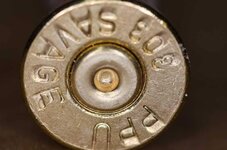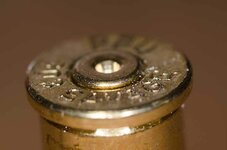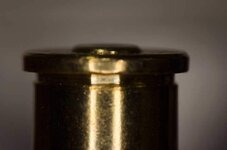- Messages
- 16
- Reactions
- 29
I recently purchased a box of .303 Savage ammo from Graf & Sons. These have 150 gr jacketed RN bullets made by Hornady. I fired them in my son-in-law's Savage '98 which I had had thoroughly inspected by my gunsmith before firing anything in it. It shot just fine with no problems except one puzzling anomaly. Every case I ejected had a slightly extruded primer, about .016" to .020". And, oddly enough, the primers do not look flattened, as would be the case with a too powerful load. Indeed, the recoil of the weapon felt nominal. Other than sticking out a little, the fired primers looked normal.
It is my understanding that the headspace on a rimmed cartridge like the .303 Savage is determined by the gap for the rim measured from the face of the bolt. Thus, if the gap is too large or the rim is too thin, I could conceive of primers backing out. The rims on my cartridges measure about .058". The data I found says it should be .063". That doesn't seem to be sufficient to cause my problem. I have nothing with which I can measure the actual headspace of the rifle. I can only assume my gunsmith did that.
And in case someone should ask, yes, the Savage is chambered for .303 Savage and which is stamped on the gun.
So what could be causing my primers to extrude? Do I need to take the Savage back to the gunsmith? Do I need to avoid Hornady ammo in .303 Savage?
I think this mystery needs to be solved before I start reloading .303 Savage.
It is my understanding that the headspace on a rimmed cartridge like the .303 Savage is determined by the gap for the rim measured from the face of the bolt. Thus, if the gap is too large or the rim is too thin, I could conceive of primers backing out. The rims on my cartridges measure about .058". The data I found says it should be .063". That doesn't seem to be sufficient to cause my problem. I have nothing with which I can measure the actual headspace of the rifle. I can only assume my gunsmith did that.
And in case someone should ask, yes, the Savage is chambered for .303 Savage and which is stamped on the gun.
So what could be causing my primers to extrude? Do I need to take the Savage back to the gunsmith? Do I need to avoid Hornady ammo in .303 Savage?
I think this mystery needs to be solved before I start reloading .303 Savage.















